2007 FIAT SEDICI fuel
[x] Cancel search: fuelPage 153 of 266
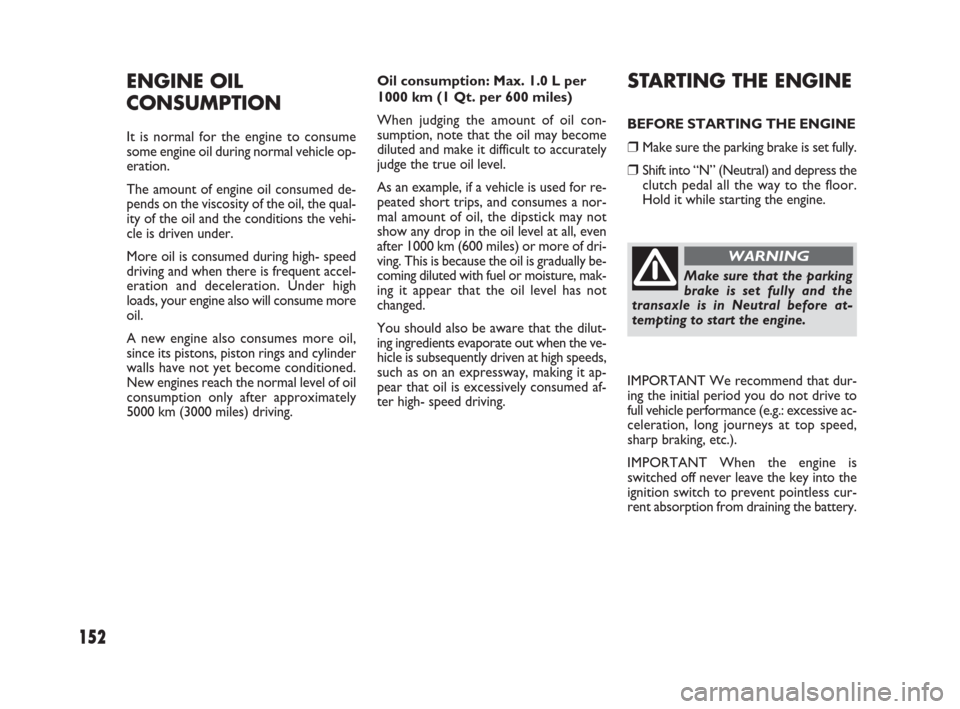
152
Oil consumption: Max. 1.0 L per
1000 km (1 Qt. per 600 miles)
When judging the amount of oil con-
sumption, note that the oil may become
diluted and make it difficult to accurately
judge the true oil level.
As an example, if a vehicle is used for re-
peated short trips, and consumes a nor-
mal amount of oil, the dipstick may not
show any drop in the oil level at all, even
after 1000 km (600 miles) or more of dri-
ving. This is because the oil is gradually be-
coming diluted with fuel or moisture, mak-
ing it appear that the oil level has not
changed.
You should also be aware that the dilut-
ing ingredients evaporate out when the ve-
hicle is subsequently driven at high speeds,
such as on an expressway, making it ap-
pear that oil is excessively consumed af-
ter high- speed driving.STARTING THE ENGINE
BEFORE STARTING THE ENGINE
❒Make sure the parking brake is set fully.
❒Shift into “N” (Neutral) and depress the
clutch pedal all the way to the floor.
Hold it while starting the engine.
ENGINE OIL
CONSUMPTION
It is normal for the engine to consume
some engine oil during normal vehicle op-
eration.
The amount of engine oil consumed de-
pends on the viscosity of the oil, the qual-
ity of the oil and the conditions the vehi-
cle is driven under.
More oil is consumed during high- speed
driving and when there is frequent accel-
eration and deceleration. Under high
loads, your engine also will consume more
oil.
A new engine also consumes more oil,
since its pistons, piston rings and cylinder
walls have not yet become conditioned.
New engines reach the normal level of oil
consumption only after approximately
5000 km (3000 miles) driving.
Make sure that the parking
brake is set fully and the
transaxle is in Neutral before at-
tempting to start the engine.
WARNING
IMPORTANT We recommend that dur-
ing the initial period you do not drive to
full vehicle performance (e.g.: excessive ac-
celeration, long journeys at top speed,
sharp braking, etc.).
IMPORTANT When the engine is
switched off never leave the key into the
ignition switch to prevent pointless cur-
rent absorption from draining the battery.
149-166 Fiat16 New GB 27-11-2007 11:27 Pagina 152
Page 154 of 266

153
STARTING A COLD ENGINE
(for petrol versions)
With your foot off the accelerator pedal,
crank the engine by turning the ignition
key to “START”. Release the key when
the engine starts.
IMPORTANT
❒Stop turning the starter immediately af-
ter the engine has started or the starter
system can be damaged.
❒Do not crank the engine for more than
15 seconds at a time. If the engine does-
n’t start on the first try, wait about 15
seconds before trying again.
If the engine does not start after 15 sec-
onds of cranking, wait about 15 seconds,
then press down the accelerator pedal to
1/3 of its travel and try cranking the en-
gine again. Release the key and accelera-
tor pedal when the engine starts.
If the engine still does not start, try hold-
ing the accelerator pedal all the way to the
floor while cranking. This should clear the
engine if it is flooded.
75J017
STARTING A COLD ENGINE
(for Diesel Engine Model)
Turn the ignition switch to the “ON” po-
sition and wait until the glow plug indica-
tor goes out if it comes on. Crank the en-
gine by turning the ignition key to
“START”. Release the key when the en-
gine starts.
IMPORTANT
❒The starter is allowed to crank the
engine up to 30 seconds. If the engine
failed to start, wait 15 seconds, then
restart cranking. Even if the third
trial failed, consult authorized Fiat
Dealership.
❒
If the engine is started after long time
parking at extremely cold atmosphere
such as the ambient temperature is be-
low –20°C, release ignition key from
start position and stop cranking after
confirming the engine speed increase
around 800 to 1000 rpm.STARTING WARM ENGINE
Crank the engine by turning the ignition
key to “START”. Release the key when
the engine starts.
CAUTION WHEN STOPPING
THE ENGINE WITH
TURBOCHARGER
When stopping the engine after climbing or
high speed driving, let the engine idle for
about one minute or more (if it is not pro-
hibited) to cool down the turbocharger and
engine oil. This is to prevent the engine oil
from over-deteriorating. Deteriorated en-
gine oil will damage the bearings of the tur-
bocharger.
RESTARTING D19AA DIESEL
ENGINE AFTER FUEL-EMPTY
STOP
The engine stops if the engine feels fuel
emptiness. To restart the engine, stop the
vehicle, hold the ignition key in “ON” po-
sition for 5 – 10 seconds to feed fuel, then
perform above engine starting procedure.
149-166 Fiat16 New GB 27-11-2007 11:27 Pagina 153
Page 155 of 266
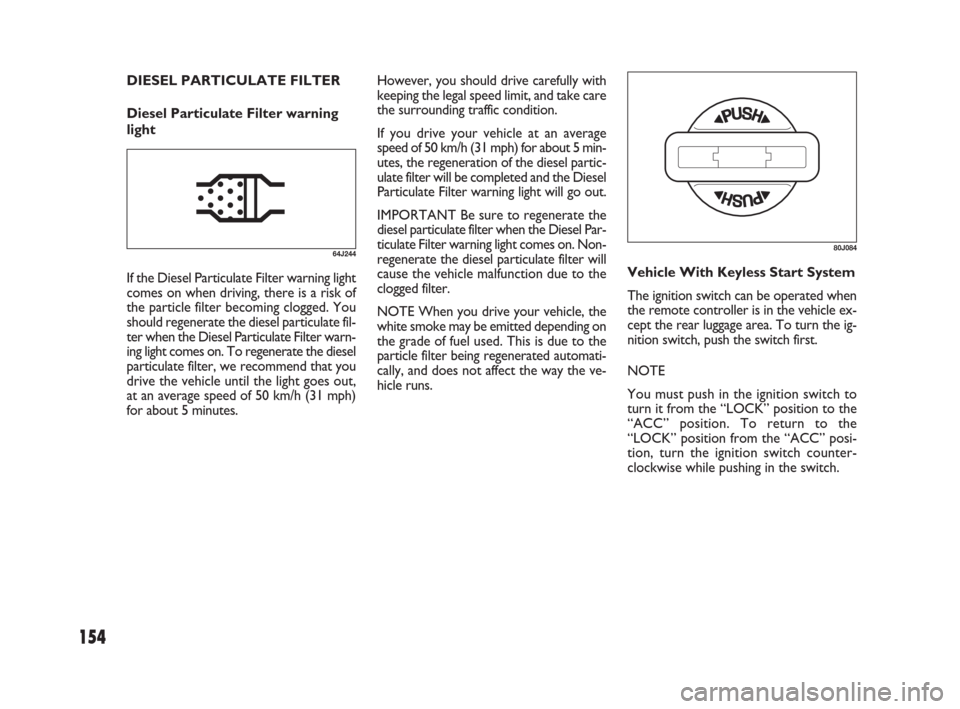
154
DIESEL PARTICULATE FILTER
Diesel Particulate Filter warning
lightHowever, you should drive carefully with
keeping the legal speed limit, and take care
the surrounding traffic condition.
If you drive your vehicle at an average
speed of 50 km/h (31 mph) for about 5 min-
utes, the regeneration of the diesel partic-
ulate filter will be completed and the Diesel
Particulate Filter warning light will go out.
IMPORTANT Be sure to regenerate the
diesel particulate filter when the Diesel Par-
ticulate Filter warning light comes on. Non-
regenerate the diesel particulate filter will
cause the vehicle malfunction due to the
clogged filter.
NOTE When you drive your vehicle, the
white smoke may be emitted depending on
the grade of fuel used. This is due to the
particle filter being regenerated automati-
cally, and does not affect the way the ve-
hicle runs.
64J244
If the Diesel Particulate Filter warning light
comes on when driving, there is a risk of
the particle filter becoming clogged. You
should regenerate the diesel particulate fil-
ter when the Diesel Particulate Filter warn-
ing light comes on. To regenerate the diesel
particulate filter, we recommend that you
drive the vehicle until the light goes out,
at an average speed of 50 km/h (31 mph)
for about 5 minutes.Vehicle With Keyless Start System
The ignition switch can be operated when
the remote controller is in the vehicle ex-
cept the rear luggage area. To turn the ig-
nition switch, push the switch first.
NOTE
You must push in the ignition switch to
turn it from the “LOCK” position to the
“ACC” position. To return to the
“LOCK” position from the “ACC” posi-
tion, turn the ignition switch counter-
clockwise while pushing in the switch.
80J084
149-166 Fiat16 New GB 27-11-2007 11:27 Pagina 154
Page 158 of 266

157
IMPORTANT Do not drive with your
hand resting on the gear lever as the force
exerted, even if slight, could lead over time
to premature wear on the gearbox inter-
nal components.
IMPORTANT
❒To help avoid clutch damage, do not
use the clutch pedal as a footrest while
driving or use the clutch to keep the ve-
hicle stationary on a hill. Depress the
clutch fully when shifting.
❒When shifting or starting off, do not
race the engine. Racing the engine can
shorten engine life and prevent smooth
shifting.
USING THE 2WD/
4WD SWITCH
(if equipped)
This 4WD system enables you to select the
driving mode according to the driving con-
ditions by operating the 2WD/4WD
switch. With this feature, you can select 3
mode positions, “2WD”, “4WD AUTO”
and “4WD LOCK” by operating the 2WD/
4WD switch even when the vehicle is mov-
ing, provided the front wheels are in the
straight ahead position.
DESCRIPTION OF TRANSFER
CASE POSITIONS
2WD
In this position, engine power is supplied
to the front axle only. Use this position
for normal driving (on dry, hard surfaces).
4WD AUTO
In this position, engine power is supplied
to the front and rear axles at normal
speed, providing greater traction than 2-
wheel drive. Use this position for driving
on paved roads or on slippery roads (icy,
snow- covered, muddy, etc.).In the AUTO mode, the 4WD controller
judges the driving conditions using signals
from sensors.
When slipping of the front wheels is de-
tected, the electronically controlled cou-
pling supplies optimum driving force to the
rear wheels. This function improves dri-
ving stability and running through perfor-
mance on rough roads and stabilizes dri-
ving performance even on a snow covered
up- hill road or the like.
Also, during normal driving on paved
roads, torque distribution to the rear
wheels is reduced to achieve the nearly
front wheel drive condition, thereby fuel
consumption is improved.
79J042
149-166 Fiat16 New GB 27-11-2007 11:27 Pagina 157
Page 166 of 266
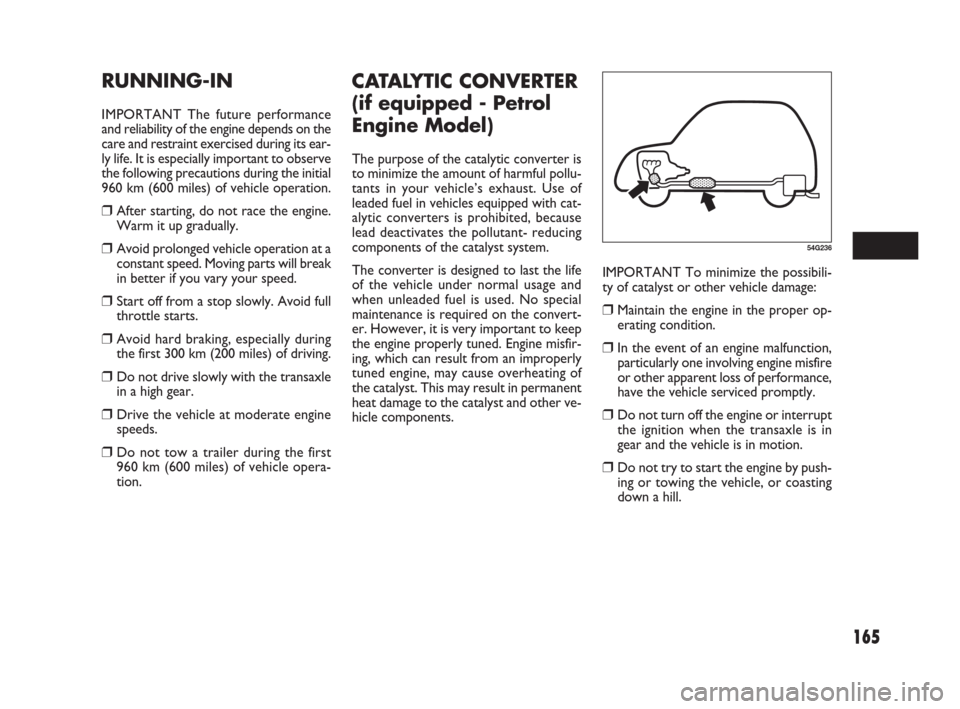
165
IMPORTANT To minimize the possibili-
ty of catalyst or other vehicle damage:
❒Maintain the engine in the proper op-
erating condition.
❒In the event of an engine malfunction,
particularly one involving engine misfire
or other apparent loss of performance,
have the vehicle serviced promptly.
❒Do not turn off the engine or interrupt
the ignition when the transaxle is in
gear and the vehicle is in motion.
❒Do not try to start the engine by push-
ing or towing the vehicle, or coasting
down a hill.
CATALYTIC CONVERTER
(if equipped - Petrol
Engine Model)
The purpose of the catalytic converter is
to minimize the amount of harmful pollu-
tants in your vehicle’s exhaust. Use of
leaded fuel in vehicles equipped with cat-
alytic converters is prohibited, because
lead deactivates the pollutant- reducing
components of the catalyst system.
The converter is designed to last the life
of the vehicle under normal usage and
when unleaded fuel is used. No special
maintenance is required on the convert-
er. However, it is very important to keep
the engine properly tuned. Engine misfir-
ing, which can result from an improperly
tuned engine, may cause overheating of
the catalyst. This may result in permanent
heat damage to the catalyst and other ve-
hicle components.
54G236
RUNNING-IN
IMPORTANT The future performance
and reliability of the engine depends on the
care and restraint exercised during its ear-
ly life. It is especially important to observe
the following precautions during the initial
960 km (600 miles) of vehicle operation.
❒After starting, do not race the engine.
Warm it up gradually.
❒Avoid prolonged vehicle operation at a
constant speed. Moving parts will break
in better if you vary your speed.
❒Start off from a stop slowly. Avoid full
throttle starts.
❒Avoid hard braking, especially during
the first 300 km (200 miles) of driving.
❒Do not drive slowly with the transaxle
in a high gear.
❒Drive the vehicle at moderate engine
speeds.
❒Do not tow a trailer during the first
960 km (600 miles) of vehicle opera-
tion.
149-166 Fiat16 New GB 27-11-2007 11:27 Pagina 165
Page 167 of 266
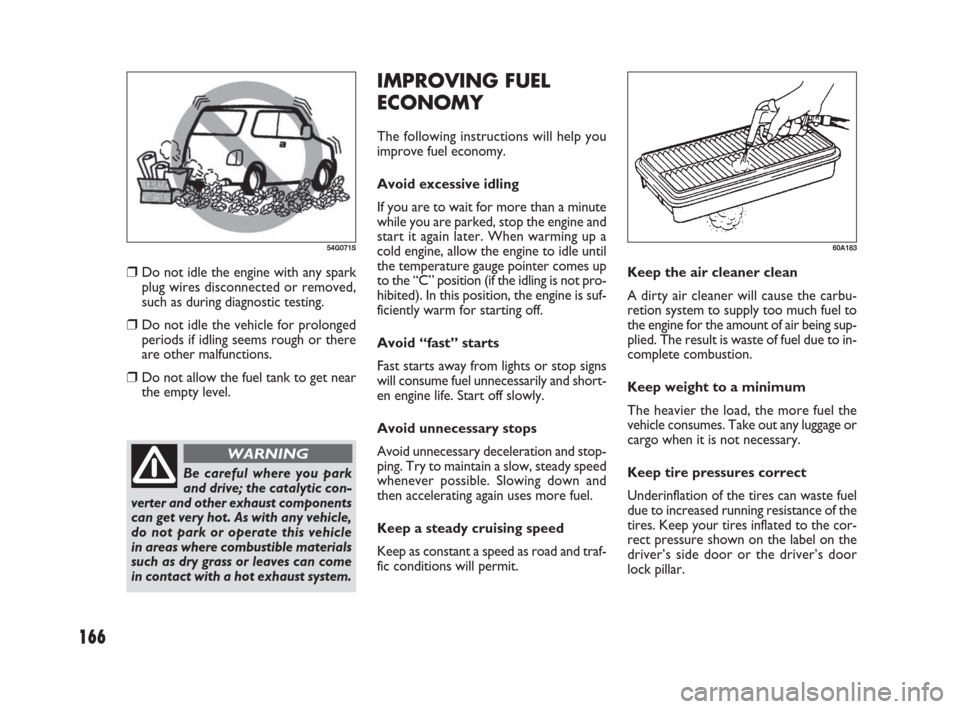
166
IMPROVING FUEL
ECONOMY
The following instructions will help you
improve fuel economy.
Avoid excessive idling
If you are to wait for more than a minute
while you are parked, stop the engine and
start it again later. When warming up a
cold engine, allow the engine to idle until
the temperature gauge pointer comes up
to the “C” position (if the idling is not pro-
hibited). In this position, the engine is suf-
ficiently warm for starting off.
Avoid “fast” starts
Fast starts away from lights or stop signs
will consume fuel unnecessarily and short-
en engine life. Start off slowly.
Avoid unnecessary stops
Avoid unnecessary deceleration and stop-
ping. Try to maintain a slow, steady speed
whenever possible. Slowing down and
then accelerating again uses more fuel.
Keep a steady cruising speed
Keep as constant a speed as road and traf-
fic conditions will permit.Keep the air cleaner clean
A dirty air cleaner will cause the carbu-
retion system to supply too much fuel to
the engine for the amount of air being sup-
plied. The result is waste of fuel due to in-
complete combustion.
Keep weight to a minimum
The heavier the load, the more fuel the
vehicle consumes. Take out any luggage or
cargo when it is not necessary.
Keep tire pressures correct
Underinflation of the tires can waste fuel
due to increased running resistance of the
tires. Keep your tires inflated to the cor-
rect pressure shown on the label on the
driver’s side door or the driver’s door
lock pillar.
60A183
❒Do not idle the engine with any spark
plug wires disconnected or removed,
such as during diagnostic testing.
❒Do not idle the vehicle for prolonged
periods if idling seems rough or there
are other malfunctions.
❒Do not allow the fuel tank to get near
the empty level.
54G071S
Be careful where you park
and drive; the catalytic con-
verter and other exhaust components
can get very hot. As with any vehicle,
do not park or operate this vehicle
in areas where combustible materials
such as dry grass or leaves can come
in contact with a hot exhaust system.
WARNING
149-166 Fiat16 New GB 27-11-2007 11:27 Pagina 166
Page 173 of 266

172
TRAILER TOWING
Your Fiat was originally designed to car-
ry people and a normal amount of cargo,
not to tow a trailer. Fiat does not rec-
ommend you use your vehicle to tow a
trailer if there is not any local regulation
about towing capacity permitted (for ex-
ample, registered or statutory towing ca-
pacity). Towing a trailer can adversely af-
fect handling, durability, and fuel economy.
Some countries have regulations which
specifically allow trailer towing up to a
specified maximum trailer weight (regis-
tered or statutory towing capacity,
whichever is smaller); vehicles sold in
these countries can be used to tow a light
trailer, provided the trailer does not ex-
ceed the maximum trailer weight specified
in the country’s regulations.
If you use your Fiat to tow a trailer, you
should always observe the requirements
and recommendations in this section. If
you intend to tow a trailer, it is essential
to select a trailer and trailer towing equip-
ment which are compatible. A reputable
towing specialist can help you.
VEHICLE LOADING
Your vehicle was designed for specific
weight capacities. The weight capacities of
your vehicle are indicated by the Gross
Vehicle Weight Rating (GVWR) and the
Gross Axle Weight Rating (GAWR, front
and rear). The GVWR and GAWR (front
and rear) are listed in the “SPECIFICA-
TIONS” section.
GVWR – Maximum permissible overall
weight of the fully loaded vehicle (includ-
ing all the occupants, accessories and car-
go plus the trailer nose weight if towing
a trailer).
GAWR – (Front and Rear) Maximum per-
missible weight on an individual axle.
Actual weight of the loaded vehicle and ac-
tual loads at the front and rear axles can
only be determined by weighing the vehi-
cle. Compare these weights to the GVWR
and GAWR (front and rear). If the gross
vehicle weight or the load on either axle
exceeds these ratings, you must remove
enough weight to bring the load down to
the rated capacity.Never overload your vehicle.
The gross vehicle weight
(sum of the weights of the vehicle, all
the occupants, accessories, cargo plus
trailer nose weight if towing a trailer)
must never exceed the Gross Vehicle
Weight Rating (GVWR). In addition,
never distribute a load so that the
weight on either the front or rear axle
exceeds the Gross Axle Weight Rat-
ing (GAWR).
WARNING
Always distribute cargo
evenly. To avoid personal in-
jury or damage to your vehicle, al-
ways secure cargo to prevent it from
shifting if the vehicle moves sudden-
ly. Place heavier objects on the floor
and as far forward in the cargo area
as possible. Never pile cargo higher
than the top of the seat backs.
WARNING
171-180 Fiat16 New GB 27-11-2007 11:29 Pagina 172
Page 182 of 266
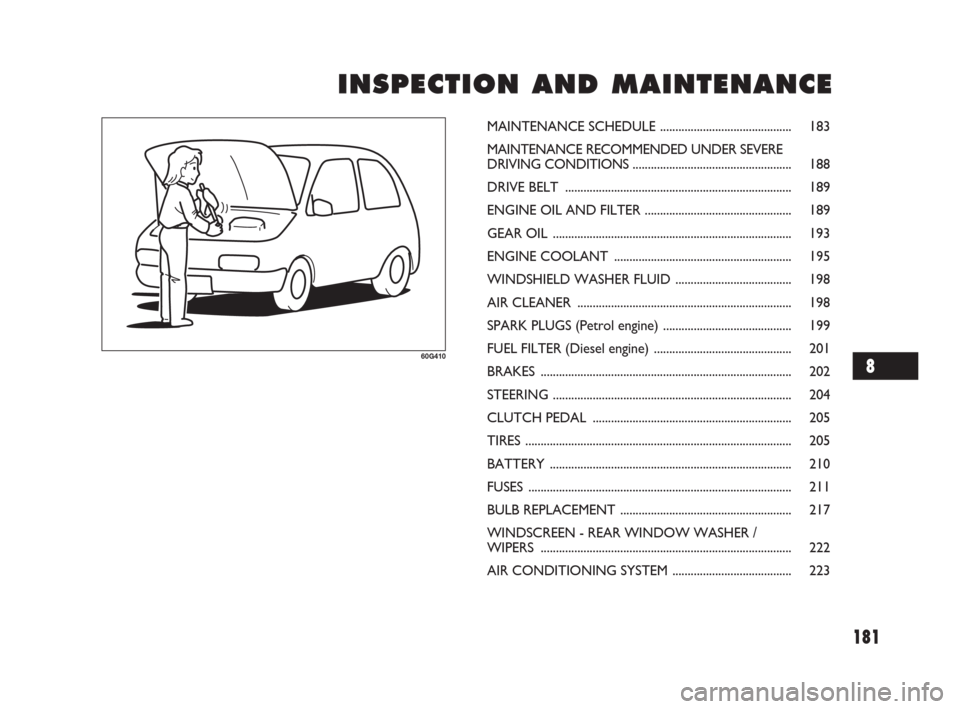
181
I I
N N
S S
P P
E E
C C
T T
I I
O O
N N
A A
N N
D D
M M
A A
I I
N N
T T
E E
N N
A A
N N
C C
E E E
60G410
MAINTENANCE SCHEDULE ........................................... 183
MAINTENANCE RECOMMENDED UNDER SEVERE
DRIVING CONDITIONS .................................................... 188
DRIVE BELT .......................................................................... 189
ENGINE OIL AND FILTER ................................................ 189
GEAR OIL .............................................................................. 193
ENGINE COOLANT .......................................................... 195
WINDSHIELD WASHER FLUID ...................................... 198
AIR CLEANER ...................................................................... 198
SPARK PLUGS (Petrol engine).......................................... 199
FUEL FILTER (Diesel engine)............................................. 201
BRAKES .................................................................................. 202
STEERING .............................................................................. 204
CLUTCH PEDAL ................................................................. 205
TIRES ....................................................................................... 205
BATTERY ............................................................................... 210
FUSES ...................................................................................... 211
BULB REPLACEMENT ........................................................ 217
WINDSCREEN - REAR WINDOW WASHER /
WIPERS .................................................................................. 222
AIR CONDITIONING SYSTEM ....................................... 223
8
181-224 Fiat16 New GB 27-11-2007 11:29 Pagina 181